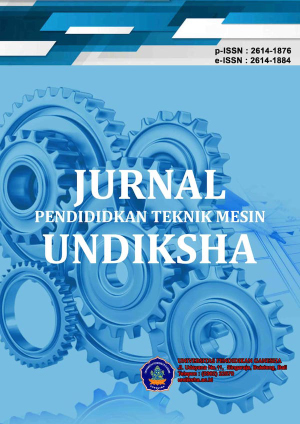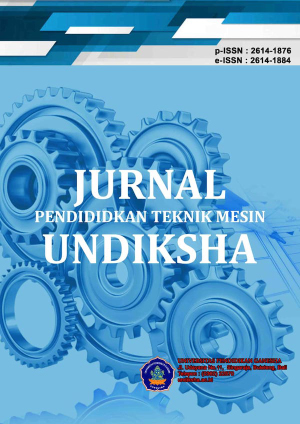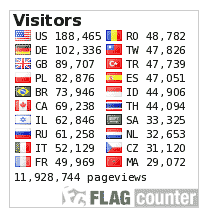Simulasi Pengaruh Waktu dan Gerak Terhadap Desain Implan Sendi Pinggul
DOI:
https://doi.org/10.23887/jptm.v9i1.28885Abstract
Simulasi desain implan sendi pinggul bertujuan untuk menganalisis total deformasi maksimum, tegangan prinsipal maksimum, dan tegangan geser maksimum dengan kombinasi variasi waktu, gerakan, dan pembebanan. Simulasi memungkinkan suatu objek diujicobakan secara visual sebelum diproduksi sebagai purwarupa. Fungsi dari simulasi adalah untuk meminimalisir terjadinya kegagalan dan untuk memangkas biaya produksi. Sebelum memulai simulasi suatu objek perlu dibuatkan desain. Desain dalam penelitian ini menggunakan software CAD yakni Inventor 2014, sedangkan analisis metode elemen hingga dalam desain implan memanfaatkan simulasi ANSYS 18.1. Analisis metode elemen hingga didasarkan pada aktivitas berjalan, melompat, dan menuruni tangga selama kurun waktu 0 detik hingga 4,5 detik. Hasil simulasi menunjukkan bahwa desain implan sendi pinggul menghasilkan 4079 nodal, 2157 Elemen, dan total deformasi maksimum sebesar 0,097 mm (berjalan), 0,2 mm (melompat), dan 0,11 mm (menuruni tangga). Tegangan prinsipal maksimum adalah 32 MPa (berjalan), 66,96 MPa (melompat), dan 73,93 MPa (menuruni tangga). Tegangan geser maksimum adalah 19,74 MPa (berjalan), 41,28 MPa (melompat), dan 45,58 MPa (menuruni tangga).
Kata kunci: simulasi; implan sendi pinggul; metode elemen hingga; Mg Alloy.
The simulation of the hip joint implant design aims to analyze maximum total deformation, maximum principal stress, and maximum shear stress with a combination of variations in time, motion and loading. Simulation allows an object to be tested visually before being produced as a prototype. Function of simulation is to minimize the occurrence of failures and to cut production costs. Before starting to simulate an object a design needs to be made. The design in this study used CAD software, namely Inventor 2014, while the finite element method analysis in implant design used ANSYS 18.1 simulation. Finite element method analysis is based on walking, jumping and descending stairs over a period of 0 seconds to 4.5 seconds. Simulation results show that hip joint implant design produces 4079 nodals, 2157 elements, and a maximum total deformation of 0.097 mm (walking), 0.2 mm (jumping), and 0.11 mm (descending stairs). Maximum principal stresses are 32 MPa (walking), 66.96 MPa (jumping), and 73.93 MPa (descending stairs). Maximum shear stresses are 19.74 MPa (walking), 41.28 MPa (jumping), and 45.58 MPa (descending stairs).
Keywords : Simulation; Hip Joint Implants; Finite Element Method; Mg Alloy
DAFTAR RUJUKAN
Ahmed, A., Hameed, P., Shaikh, F., Hussain, Z., Hussain, N., & Aslam, M. (2017). Simulation tools application for arti fi cial lighting in buildings. Renewable and Sustainable Energy Reviews, August, 0–1. https://doi.org/10.1016/j.rser.2017.10.035
Boyd, D. D. (2016). General aviation accidents related to exceedance of airplane weight/center of gravity limits. Accident Analysis and Prevention, 91, 19–23. https://doi.org/10.1016/j.aap.2016.02.019
Conlisk, N., Howie, C. R., & Pankaj, P. (2017). Computational modelling of motion at the bone–implant interface after total knee arthroplasty: The role of implant design and surgical fit. The Knee, 24(5), 994–1005. https://doi.org/10.1016/j.knee.2017.07.003
Constantinou, M., Loureiro, A., Carty, C., Mills, P., & Barrett, R. (2017). Hip joint mechanics during walking in individuals with mild-to-moderate hip osteoarthritis. Gait and Posture, 53, 162–167. https://doi.org/10.1016/j.gaitpost.2017.01.017
Gu, X., Shiflet, G. J., Guo, F. Q., & Poon, S. J. (2005). Mg–Ca–Zn Bulk Metallic Glasses with High Strength and Significant Ductility. Journal of Materials Research, 20(08), 1935–1938. https://doi.org/10.1557/JMR.2005.0245
Guo, W., Cui, W., Shi, Y., Liu, J., & Song, B. (2016). Function failure and failure boundary analysis for an aircraft lock mechanism. Engineering Failure Analysis, 70, 428–442. https://doi.org/10.1016/j.engfailanal.2016.10.003
Hagihara, K., Shakudo, S., Fujii, K., & Nakano, T. (2014). Degradation behavior of Ca – Mg – Zn intermetallic compounds for use as biodegradable implant materials. Materials Science & Engineering C, 44, 285–292. https://doi.org/10.1016/j.msec.2014.08.037
Hutař, P., Poduška, J., Šmíd, M., Kuběna, I., Chlupová, A., Náhlík, L., Polák, J., & Kruml, T. (2017). Short fatigue crack behaviour under low cycle fatigue regime. International Journal of Fatigue, 103, 207–215. https://doi.org/10.1016/j.ijfatigue.2017.06.002
Kiani Khouzani, M., Bahrami, A., & Eslami, A. (2018). Metallurgical aspects of failure in a broken femoral HIP prosthesis. Engineering Failure Analysis, 90(November 2017), 168–178. https://doi.org/10.1016/j.engfailanal.2018.03.018
Lestari, F. P., Kartika, I., Sriyono, B., Puspiptek, K., Tangerang, S., & Banten, S. (2013). Pengaruh Waktu Milling Pada Paduan Mg-Ca-Zn-CaH 2 Untuk Aplikasi Implan.
Liu, X., Guo, J., Bai, C., Sun, X., & Mou, R. (2015). Drop test and crash simulation of a civil airplane fuselage section. Chinese Journal of Aeronautics, 28(2), 447–456. https://doi.org/10.1016/j.cja.2015.01.007
Longman, J., Veres, D., & Wennrich, V. (2018). Utilisation of XRF core scanning on peat and other highly organic sediments. Quaternary International, January, 0–1. https://doi.org/10.1016/j.quaint.2018.10.015
Meischel, M., Hörmann, D., Draxler, J., Tschegg, E. K., Eichler, J., Prohaska, T., & Stanzl-Tschegg, S. E. (2017). Bone-implant degradation and mechanical response of bone surrounding Mg-alloy implants. Journal of the Mechanical Behavior of Biomedical Materials, 71, 307–313. https://doi.org/10.1016/j.jmbbm.2017.03.025
Mutlu, I. (2018). Production and fluoride treatment of Mg-Ca-Zn-Co alloy foam for tissue engineering applications. Transactions of Nonferrous Metals Society of China (English Edition), 28(1), 1–8. https://doi.org/10.1016/S1003-6326(18)64644-8
Riccio, A., Cristiano, R., Saputo, S., & Sellitto, A. (2018). Numerical methodologies for simulating bird-strike on composite wings. Composite Structures. https://doi.org/10.1016/j.compstruct.2018.03.018
Saini, M. (2015). Implant biomaterials: A comprehensive review. World Journal of Clinical Cases, 3(1), 52. https://doi.org/10.12998/wjcc.v3.i1.52
Šamec, B., Potrč, I., & Šraml, M. (2011). Low cycle fatigue of nodular cast iron used for railway brake discs. Engineering Failure Analysis, 18(6), 1424–1434. https://doi.org/10.1016/j.engfailanal.2011.04.002
Saulacic, N., Bosshardt, D. D., Bornstein, M. M., Berner, S., & Buser, D. (2012). BONE Apposition To A Titanium-Zirconium Alloy Implant , As Compared To Two Other Titanium-Containing Implants. 273–288.
Seguin, C., Blaquière, G., Loundou, A., Michelet, P., & Markarian, T. (2018). Unmanned aerial vehicles ( drones ) to prevent drowning ☆. Resuscitation, 127(January), 63–67. https://doi.org/10.1016/j.resuscitation.2018.04.005
Shi, K. K., Cai, L. X., Chen, L., Wu, S. C., & Bao, C. (2014). Prediction of fatigue crack growth based on low cycle fatigue properties. International Journal of Fatigue, 61, 220–225. https://doi.org/10.1016/j.ijfatigue.2013.11.007
Yatim, F. (2006). Penyakit Tulang dan Persendian (Arthristis atau Arthralgia). Pustaka Populer Obor.
Zameer, S., & Haneef, M. (2015). Fatigue Life Estimation of Artificial Hip Joint Model Using Finite Element Method. Materials Today: Proceedings, 2(4–5), 2137–2145. https://doi.org/10.1016/j.matpr.2015.07.220
Zander, D., & Zumdick, N. A. (2015). Influence of Ca and Zn on the microstructure and corrosion of biodegradable Mg-Ca-Zn alloys. Corrosion Science, 93(January), 222–233. https://doi.org/10.1016/j.corsci.2015.01.027
Downloads
Published
Issue
Section
License

Jurnal Pendidikan Teknik Mesin Undiksha is licensed under a Creative Commons Attribution-ShareAlike 4.0 International License.










